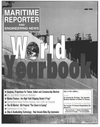
Page 82: of Maritime Reporter Magazine (June 1998)
Read this page in Pdf, Flash or Html5 edition of June 1998 Maritime Reporter Magazine
COATINGS & CORROSION CONTROL
Impoct Of Solvent Regulations On Ship Coating Users by Dr. Bernard R. Appleman, Executive Director, SSPC: The Society for Protective Coatings
This article describes some recent regulations affecting use of volatile solvents in coatings for ships. The operational, economic and other impacts are discussed for
U.S. Navy and private ships and structure owners.
Ship owners and operators are increasingly recognizing the signif- icance of coating systems for the effective construction, operation and maintenance of oceangoing vessels. Proper design, selection, and application of coatings can reduce the overall cost to owners and operators by minimizing downtime for maintenance and repair and by reducing fuel con- sumption and increasing vessel speed. In the drive to produce ships both quickly and competitively, however, owners have sought to reduce both construction and main- tenance costs, with coatings often being a major area for reductions.
Another important trend is the development of environmental reg- ulations regarding the manufac- ture, application and disposal of shipboard coatings. An important area of regulation is air quality, which is significantly affected by the emission of volatiles during the application and curing of coatings.
The following is a review of the recent round of U.S. EPA regula- tions on the emission of volatile components of coatings and the impact these rules are having on shipyards doing both commercial and US Navy shipbuilding and repair.
Recent Regulations on VOCs and HAPs for Shipbuilding
In the last three years, the U.S.
EPA has proposed and enacted sig- nificant new regulations affecting the solvents in organic and inor- ganic coatings used in shipyards.
In the past, regulations have been concerned with volatile organic compounds (VOCs). VOCs are pre- cursors to ozone, an air pollutant, which adversely affects the human respiratory system and damages crops and forests. It has been the target of regulations in the US since 1966 in California (Rule 66) and since 1970 nationwide (Clean
Air Act).
Under the 1990 CAA EPA iden- tified an additional 189 compounds for substances that were consid- ered hazardous when airborne.
These are designated as
Hazardous Air Pollutants or HAPs.
HAPs include most (but not all) commonly used coating solvents (toluene, MEK, xylene, MIBK).
Mineral spirits is a VOC, but not a
HAP. In 1994, EPA determined that for the shipbuilding regula- tion, VOCs would serve as a surro- gate for HAPs. Reducing VOC emission would automatically reduce volatile HAPs emissions as well. However, because these two classes of compounds fall under different portions of the regulatory
What makes a shower SAFE?
V Automatic shut down if the hot or cold water is interrupted
V Thermostatic and Pressure Balancing anti-scald valve. Holds water temperature variations to ±2°F
V Hot water safety stop
V Helps fight Legionellae & bacteria
On/Off knob
Safety Stop
FMMattsson
Now approved by the American
Bureau of
Shipping
To shower head
Set once temperature control
Scanmix Corporation 230 Bartlett Street
Lewiston, Maine 04240 (207)782-1885 fax (207) 782-1914 http://www.safeshower.com
Circle 243 on Reader Service Card
Stay Cool!
BAILEY CAN FILL
YOUR EVERY REFRIGERATION
AND AIR CONDITIONING NEED.
NOT JUST FASTER...BETTER!
A 600-ton air conditioning system with a state-of-the-art Helical Screw Compressor?
Emergency repairs to an ice maker? Fast help in complying with public health regulations?
Whatever your needs, throughout the ports of America, only Bailey has what it takes to get things done when you need them: • A vast inventory of repair and replacement parts from flare nuts to compressors! • Full lines of top name equipment including: York; Carrier; Kold Draft; and
BAILEY
W THE BAILEY GROUP
TWtJudfr^ ..fatten!
Dunham-Bush screw machine air condi- tioning — in stock for off-the-shelf delivery! • The personnel — factory-trained repair people; skilled craftsmen for new installa- tions; and a large professional engineering staff ready to tackle anything!
In fact, no problem concerning refrigerated storage, ice making, water cooling or air conditioning for any vessel afloat is too big, too small, or too urgent for Bailey.
Headquarters: Bailey Refrigeration Co. 2323 Randolph Ave., Avenel, NJ 07001
Tel: 732-382-1225 • Fax: 732-382-1048
Email: [email protected]
Web Site: www.baileyco.com
Offices & Warehouses:
New Orleans, LA
Tel: 504-943-2461 • Fax: 504-944-8629
Norfolk, VA
Tel: 757-456-9157 • Fax: 757-497-8785 201 East Lincoln Hwy, Penndel, PA 19047-4097
CALL 215-757-2404 • FAX 215-757-7105
CALL TOLL FREE 1-800-752-7595
Ipeffler •• CORPORATION
U.S. Navy Ships have been fitted with Loeffler deck drains, valves, and bells for over 40 years. They are precision made to the latest applicable
NAVSEA. BUSHIPS, or MIL standard.
If you are building for the U.S. Navy or Coastguard, you need Loeffler.
June, 1998 Circle 204 on Reader Service Card Circle 118 on Reader Service Card 59

 81
81

 83
83
